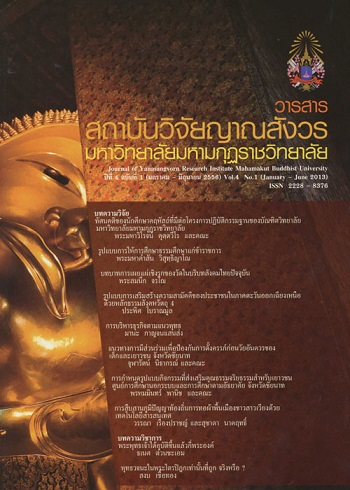AGGRESSIVE PROPAGATION OF TEMPLES IN CONTEXTS OF MODERN THAI SOCIETY
Main Article Content
Abstract
The purposes of this study were to 1) study the temples’ proactive propagation roles in the modern Thai society and in the former time., 2) to study the participants’ participation in Jumku Temple’s ’ activities, 3) to make comparison among participants’ opinions towards their participation in the temple’s activities, 4) to study the participants’ suggestion towards Jumku Temple’s proactive propagation roles in the modern Thai society. The samples consisted of 372 participants from 4 villages around Jumku Temple , Sribouban Sub District, Muang District, Lumpoon province. Questionnaires were distributed to gather data, followed by a Focus Group of 7 selected representatives and an In depth Interview of 12 the high ranked monks in the area. The statistics used included the descriptive statistics, the t-test, the analysis of variance , the Sheffe’ procedure and the Pearson product moment of correlation co efficiency. The findings were as follows: 1. The majority of the samples or about 55.1 percent participated in 1-4 projects offered by Jumku Temple. 2. Most participants or about 10.5 percent participated the creation of Buddhism’s heritance Project 3.The majority of samples or about 42.2 percent received the information of Jumku Temples through the temple’s brochures or leaflets. 4. Most participants or about 47.3 percent participated in activities offer By Jumku Temple at the temple. 5. The majority of samples was female or 72.8 percent at the average of an age group of above 20 years old or about 75 percent with their educational background at a the secondary or certificate in vocation education level of 45.2 percent. 6. The analysis of the questionnaires revealed that the samples were satisfied with the role for the Public Welfare with a mean of 4.42. 7. Hypothesis testing revealed significant relationship between personal factors at the 0.05 level of statistical significance. Male and Female participants had similar opinions towards Jumku Temple’s proactive propagation roles at the significant level of .938 8. Participants with different background of education level viewed towards Jumku Temple’s proactive propagation roles differently at the significant level of .049 9. Participants with different age groups demonstrated no different views towards Jumku Temple’s proactive propagation roles at the significant level of . 549 10. ALERT MODEL was the model obtained from the analysis of the data.
Article Details
References
มหาจุฬาลงกรณราชวิทยาลัย. พระไตรปิฎกภาษาไทย ฉบับมหาจุฬาลงกรณราชวิทยาลัย.กรุงเทพมหานคร : โรงพิมพ์มหาจุฬาลงกรณราชวิทยาลัย, 2539.
กรมการศาสนา กระทรวงศึกษาธิการ, คู่มือครูจริยศึกษา, ชั้นประถมศึกษาปีที่ 3 เล่ม 6, กรุงเทพฯ : กรมการศาสนา กระทรวงศึกษาธิการ, 2522.
กระทรวงศึกษาธิการ, ประวัติการศึกษาของสงฆ์, กรุงเทพมหานคร : โรงพิมพ์กรมการศาสนา, 2525.
การศาสนา, กรม. พระราชบัญญัติคณะสงฆ์ พ.ศ. 2505 แก้ไขเพิ่มเติมโดยพระราชบัญญัติคณะสงฆ์ (ฉบับที่ 2) พ.ศ. 2535. กรุงเทพมหานคร : โรงพิมพ์การศาสนา, 2536.


